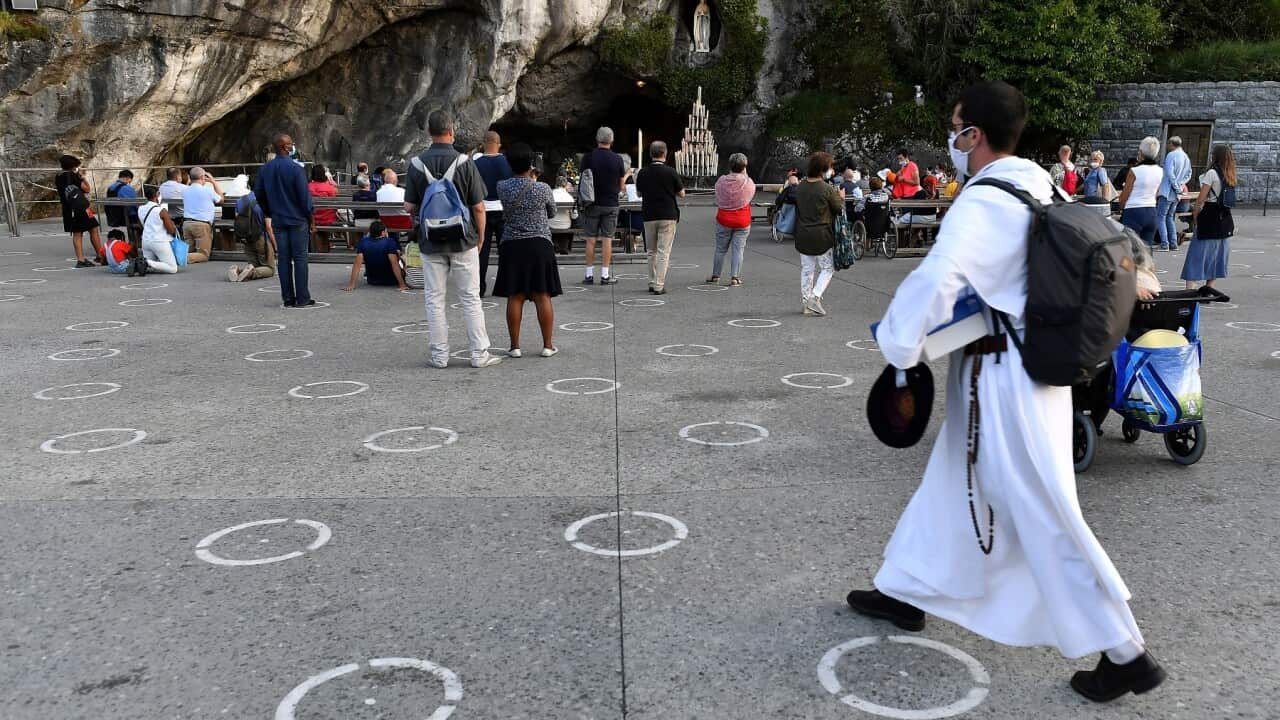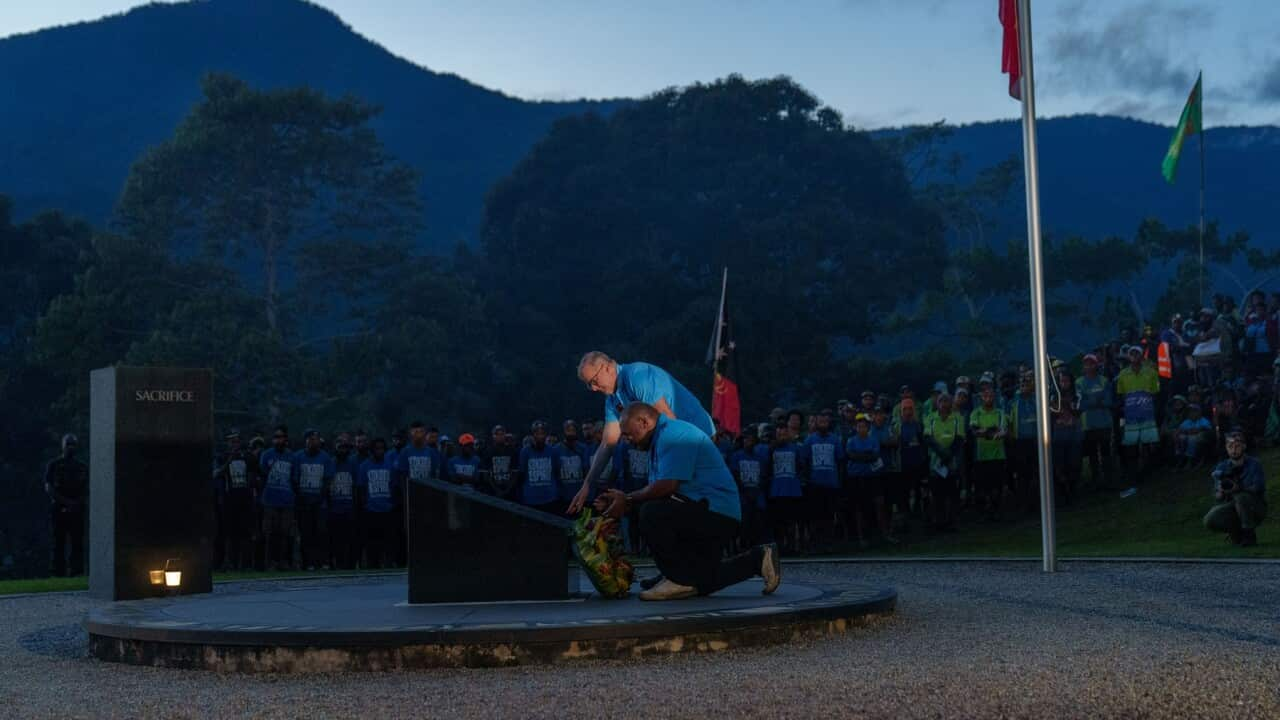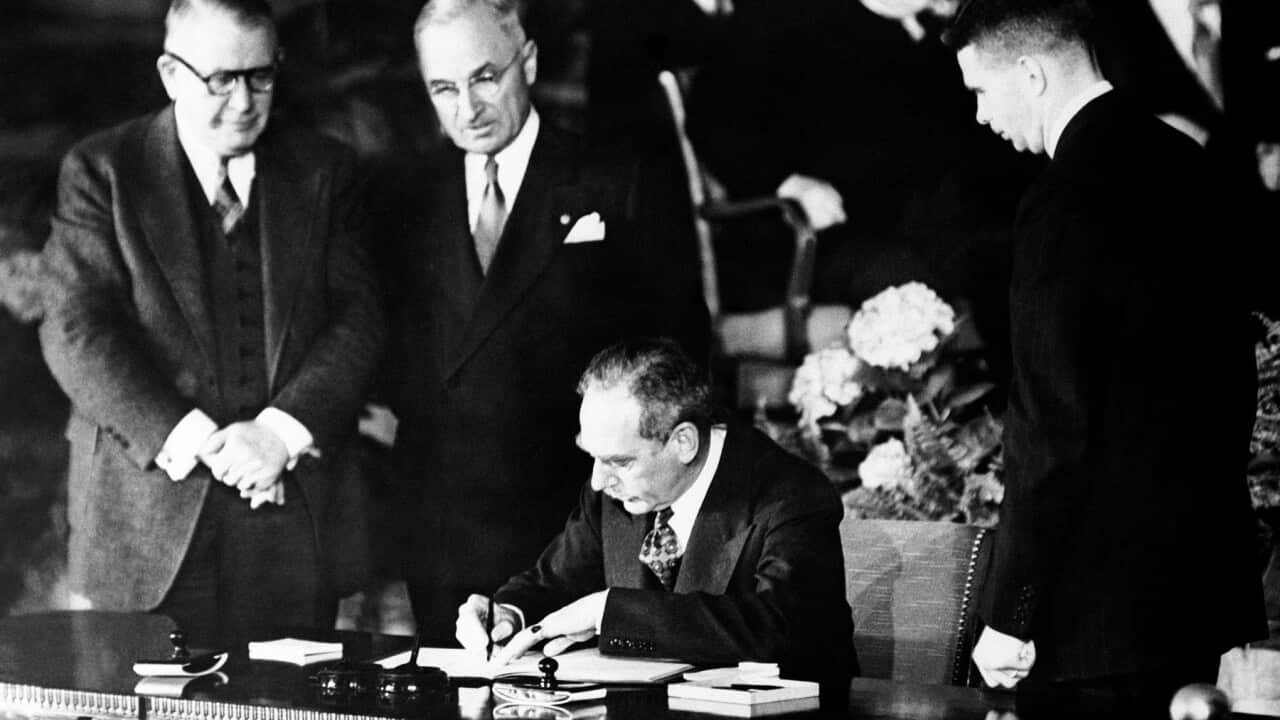Italian
In questo periodo dell'anno, circa 15mila persone al giorno visitano il santuario nella cittadina di Lourdes.
Ma oggi, di fronte alla caverna in cui si tramanda apparve la Vergine Maria, si possono trovare più o meno appena 30 persone, in ginocchio per la preghiera del pomeriggio.
Ma non fatevi ingannare, perché ci sono videocamere e microfoni sistemati per registrare la messa e trasmetterla ad un pubblico sparso in tutto il mondo.
All'inizio di ogni messa, il sacerdote di servizio si rivolge alla comunità di preghiera globale.
PRIEST: "Although we are not that many because of this epidemic, we are linked throughout the world as pilgrims doing this in a very spiritual way, through the Internet."
Qualche centinaio di metri più in là si trovano i Lourdes Studios, dove un tecnico si destreggia tra 20 videocamere diverse per trasmettere la messa in diretta.
Messa che viene trasmessa su Lourdes Web TV, e per tutti i paesi francofoni nel mondo attraverso KTO, il canale cattolico francese.
Mathias Terrier è a capo della squadra di trasmissioni del santuario.
French then VO: "The backbone of this sanctuary of Lourdes are the officially organised pilgrimage groups and most of them are cancelled. But the members want to maintain a spiritual link, even if they can't come in person. That's why we worked with them to put in place virtual pilgrimages or prayer services in front of the grotto, broadcast specifically for them, in their own languages."
Ogni giorno le funzioni religiose vengono tenute in francese, inglese, italiano, spagnolo e occasionalmente in cinese e coreano, mentre i canali religiosi di tutto il globo si connettono e disconnettono.
C'è anche uno studio radiofonico ben equipaggiato e frequenti eventi su Facebook Live con i religiosi.
Dall'inizio della pandemia, le visualizzazioni sono balzate da uno a cinque milioni al giorno.
I followers sui social media sono aumentati del 40 per cento.
Ma il rettore del santuario, Olivier Ribadeau Dumas insiste che si tratta solo di una soluzione temporanea.
French then VO: "The goal of all these broadcasts is not to find a way of keeping pilgrims at a distance, but to create a desire for them to return to Lourdes. A pilgrimage sitting on your couch doesn't work. Our objective is to support the faithful in their prayers and strengthen their bond with the Virgin Mary and encourage them to return as soon as they can."
Fuori dal santuario, tutto è stranamente calmo.
Lourdes possiede il maggior numero di hotel in Francia dopo Parigi, ma con le sue insegne un po' retrò e le luci tutte spente sembra di essere su un set di un vecchio film.
Lisa Dodd di Tangney Tours - che di solito porta 10mila pellegrini all'anno dal Regno Unito a Lourdes - sta tentando un approccio interattivo per rimanere in contatto con i clienti.
"We know that they are missing Lourdes because we get a lot of repeat business - they would come back year after year and so missing one year of their annual pilgrimage is a big deal to them and we understand that, so we've been doing what we can to let people know that we're remembering them here in Lourdes, making videos for groups that want to see us lighting candles..."
Anche se il loro gregge non è fisicamente presente, i gruppi religiosi a Lourdes stanno realizzando progetti per rimanere connessi con i fedeli in tutto il mondo.
Lo scorso luglio, il santuario ha organizzato un evento trasmesso per un giorno intero chiamato 'Lourdes United'.
Diciotto milioni di persone si sono connessi per assistere, ed il software della stazione è collassato quando i broadcaster indiani hanno iniziato a trasmettere il segnale in diretta.
Mentre la pandemia continua a respingere i pellegrini, il desiderio dei fedeli di sentirsi connessi è chiaramente più forte che mai.
English
At this time of year, around 15,000 people visit the sanctuary in the town of Lourdes each day.
But today, in front of the cave where the Virgin Mary is said to have appeared, you are more likely to find just 30 people or so, kneeling for afternoon prayers.
But that's deceptive.
Because there are cameras and microphones in place to pick up the mass and broadcast it to an audience, worldwide.
At the beginning of each mass, the on-duty priest addresses that global prayer community.
PRIEST: "Although we are not that many because of this epidemic, we are linked throughout the world as pilgrims doing this in a very spiritual way, through the Internet."
A few hundred metres away are the Lourdes Studios, where a technician is juggling between 20 different cameras to send the mass out live.
It goes out on Lourdes Web TV, and all Francophone countries worldwide through the French Catholic TV channel, KTO.
Mathias Terrier is the head of the sanctuary's broadcast team.
French then VO: "The backbone of this sanctuary of Lourdes are the officially organised pilgrimage groups and most of them are cancelled. But the members want to maintain a spiritual link, even if they can't come in person. That's why we worked with them to put in place virtual pilgrimages or prayer services in front of the grotto, broadcast specifically for them, in their own languages."
Every day, prayer services are held in French, English, Italian and Spanish and occasionally in Chinese and Korean as religious channels across the globe dip in and out.
There is also a well equipped radio studio and frequent Facebook Live events with clergy.
Since the pandemic, views have soared from one to five million a day.
Followers on social media have jumped 40 per cent.
But the Rector of the sanctuary, Olivier Ribadeau Dumas insists its only a temporary solution.
French then VO: "The goal of all these broadcasts is not to find a way of keeping pilgrims at a distance, but to create a desire for them to return to Lourdes. A pilgrimage sitting on your couch doesn't work. Our objective is to support the faithful in their prayers and strengthen their bond with the Virgin Mary and encourage them to return as soon as they can."
Away from the sanctuary, it's eerily quiet.
Lourdes has the most hotels in France, except for Paris - but with their slightly 'retro' signage and lights all switched off, it feels more like an old film set.
Lisa Dodd of Tangney Tours - which usually brings 10,000 pilgrims a year to Lourdes from the UK - is also trying an interactive approach to stay in contact.
"We know that they are missing Lourdes because we get a lot of repeat business - they would come back year after year and so missing one year of their annual pilgrimage is a big deal to them and we understand that, so we've been doing what we can to let people know that we're remembering them here in Lourdes, making videos for groups that want to see us lighting candles..."
While their flock may not be physically present, religious teams in Lourdes are pushing ahead with plans to stay connected with the faithful around the world.
Last July, the sanctuary organised a day-long broadcasting event called 'Lourdes United'.
Eighteen million people tuned in, the station's software crashing when Indian broadcasters picked up the live signal.
While the pandemic continues to keep the pilgrims away, the desire of the faithful to feel connected is clearly stronger than ever.
Report by Chris Bockman




